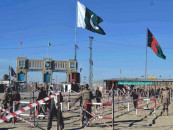Troubled partnership: Pakistan-US relations to remain rocky, says Munter
US envoy pledges greater effort to ensure Pakistanis feel fruits of US aid.

While the spectre of the Haqqani network haunted Sunday night’s talks between Pakistan’s Foreign Minister Hina Rabbani Khar and her American counterpart Hillary Clinton, the US ambassador to Pakistan predicted that relations between the war partners will remain rocky.
But at the same time, Cameron Munter pledged greater effort to ensure that ordinary Pakistanis feel the fruits of US aid. In blunt remarks during a visit to New York, Ambassador Munter insisted that Pakistan has made progress in some areas – such as improving relations with India – but acknowledged shortcomings.
“I want to be straightforward about this. This has been a rough year for our time with Pakistan and the difficulties that we’ve faced, the difficulties in the relationship, are going to continue,” Munter said at the Asia Society.
“If I give myself a report card for the last year, C or D,” he said.
Munter pointed to the Pakistani decision to throw out US trainers after US forces conducted a top-secret raid in May that killed Osama bin Laden in Abbottabad.
Munter also noted the tensions over CIA employee Raymond Davis, who was arrested for shooting dead two men in Lahore.
(Read: Ties with America)
The US Congress in 2009 approved a five-year, $7.5 billion aid package for Pakistan, hoping to fight anti-American sentiment by investing in civilian institutions instead of just the military.
But Munter said that much of the assistance has been “invisible” to Pakistanis as it involved small projects and grants.
Munter said the United States will now put a priority on boosting Pakistan’s energy supply, a major concern in a country with frequent blackouts and a rapidly growing population.
(Read: Energy assistance - US asks Pakistan for ‘realistic wish list’)
“We’re going to push hard in energy and it’s going to cost a fair amount of American money, but it’s an investment in something that everyone in that country is going to feel,” he said.
Appearing next to Munter, Rajiv Shah, head of the US Agency for International Development, said assistance has supported 170,000 “employment opportunities” and construction of 1,500 sites such as schools and clinics.
“We don’t always talk about these results, but we need to because the programs can work and they make a big difference,” he said.
Opinion polls show that the overwhelming majority of Pakistanis hold negative views of the United States.
The aid has also drawn criticism in the United States, with several lawmakers trying unsuccessfully to cut off civilian assistance after bin Laden’s discovery in Pakistan.
Published in The Express Tribune, September 20th, 2011.



















COMMENTS
Comments are moderated and generally will be posted if they are on-topic and not abusive.
For more information, please see our Comments FAQ